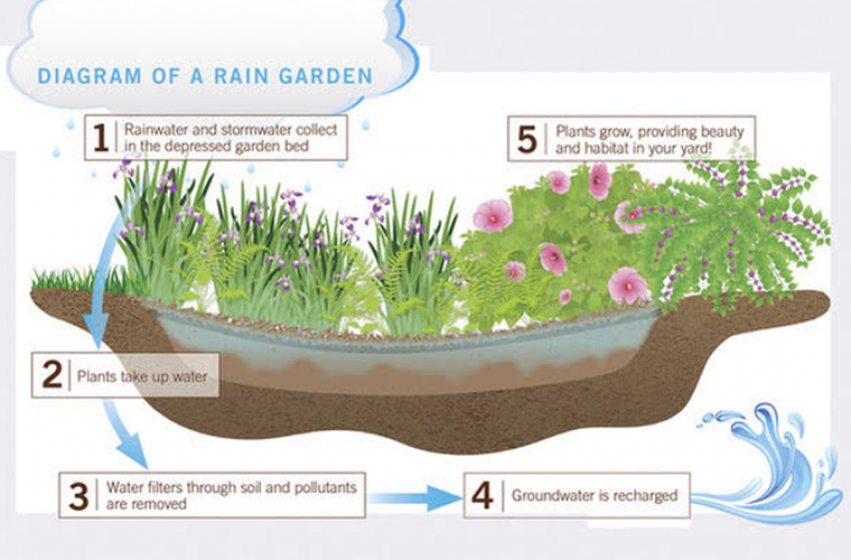A rain garden is a shallow planted depression in the landscape that is designed to retain water runoff from roofs, driveways, roads, parking lots (asphalt) and other impervious surfaces. Just like natural wetlands, these retention areas hold water from storms and give it time to soak into the ground or evaporate back into the atmosphere rather than enter directly into lakes, rivers, wetlands, and storm sewer systems. Even if the retention area overflows, a great deal of the contaminating materials have time to settle out before the water escapes into the bay or other bodies of water.
RAIN GARDEN BENEFITS
Today, governments and organizations encourage homeowners to build rain gardens to help protect the bay and other natural water sources. When planted with native grasses and flowering perennials, rain gardens can be a cost effective, low maintenance and attractive way to reduce and filter runoff from your property. Other benefits of rain gardens include:
- Minimizes the need for mowing, pesticides, pruning, irrigation and fertilization.
- Removes pollutants from water before it enters surface waters.
- Prevents erosion by holding soil in place.
- Provides food and habitat to wildlife.
- Allows for garden creativity.
HOW TO PLANT A RAIN GARDEN
Rain garden designs can be simple or elaborate, depending on your gardening interest and experience. Follow these steps when planning and installing a rain garden:
- Pick a low point in the property. Find a low spot that is fairly flat with soil. Locations that allow standing water to drain within a day or two after a storm are best suited.
- Determine the size and shape. Rain gardens vary in size and can fit into many shapes and spaces.
- Remove the soil to 18-24 inches. For best infiltration, the bottom of the rain garden should be level.
- Back fill with a sand and organic mix. Replace heavy soil with one-half sand, one-quarter compost, and one-quarter topsoil. The sand mix retains the water just like natural bog areas.
- Add plants from the list of rain garden approved plants provided below.
- Spread a 3-inch layer of mulch. This will help keep the soil moist and in place and prevent weed seeds from sprouting.
- Direct downspouts and other runoff to the rain garden. If water does not naturally flow to your rain garden, dig a shallow (3 to 4-inch deep) trench from your downspout to the garden, line it with landscape fabric, and cover with stones to create a streambed effect.
RAIN GARDEN MAINTENANCE
Rain gardens require little maintenance once established. Maintenance tasks include:
- Watering plants regularly if there has been a lack of significant rainfall.
- Regularly weed, prune, and mulch the garden.
- Routinely clean the downspout connection to prevent from clogging.
- Removing trash or other debris from the rain garden.
RAIN GARDEN PLANTS
Rain gardens are best when planted with native plants that are indigenous to our area. These plants require less maintenance once established, have deep roots that soak up lots of water, provide food and habitat to wildlife, and are beautiful. Remember, plants must be able to live with their roots in standing water for periods of time and also survive periods of drought. Rain garden plants include:
Winterberry Holly
Joe Pye Weed
Cardinal Flower (Lobelia)
River Birch
Perennial Hibiscus
Daylily
Acorus
Swamp Milkweed
Panicum
Juncus
Sea Oats
Service berry
Virginia Sweetspire
Yaupon Holly
Wax Myrtle aka Bayberry
For additional resources on rain gardens, visit the Virginia Agricultural Research and Extension Center website here or the City of Norfolk website here.

